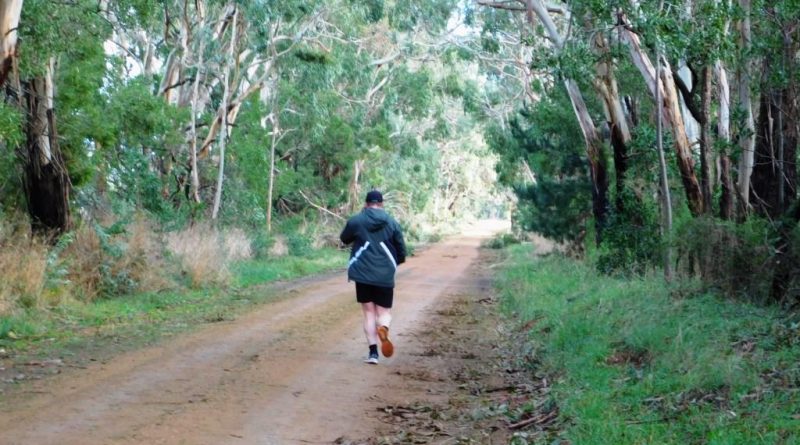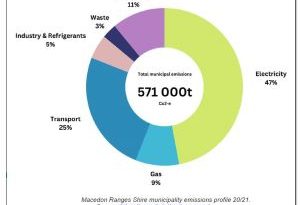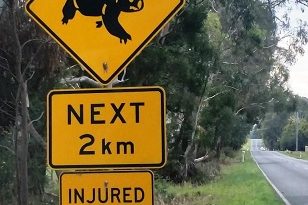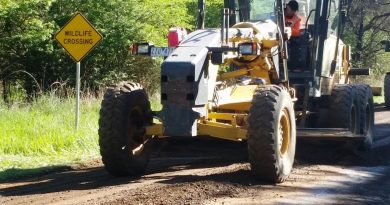50km per hour limit on minor rural roads – Key to Macedon Ranges pedestrian and bikers safety
Figure above: Photo: Jogger on Black Range road Romsey – Patrick Francis.
By Patrick Francis
The Macedon Ranges Shire Council (MRSC) Mobility and Road Safety Strategy 2021 highlights in its web site preamble that “the key objectives of the strategy will support the creation of a community in which:
- People of all ages and abilities can achieve optimal health and wellbeing
- Active mobility is prioritised
- There is equity of access and opportunity
- Mobility protects and enhances the natural environment
- People can access locations in a safe and timely manner
- Everyone can share in the region’s economic vitality.”
There is no reference to the application of these objectives to different types of roads under the council’s jurisdiction for management and safety. Over the last five years there have been significant changes to how some minor rural roads adjacent to the Shire’s major towns are being used by the public for exercise and interaction with nature. The different road categories are listed the Council’s Draft Roadside Management Plan 2021, table 1.
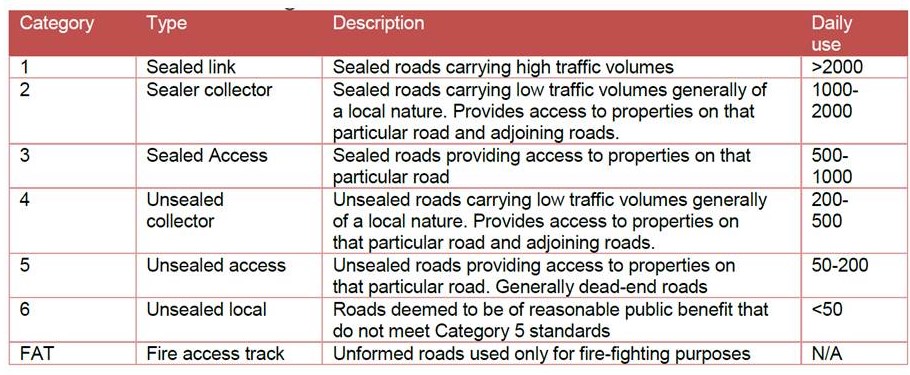
Table 1: Macedon Ranges Shire Local Road Categories. Source: MRSC Draft Roadside Management Plan 2021.
It is important for the proposed Mobility and Road Safety strategy to account for local road categories 3, 4, 5 and 6 within a 5km radius of Shire towns as the expanding populations has created a new and emerging group of road user – pedestrians, bike and horse riders and joggers. Many local rural roads outside town boundaries particularly those with natural habitat on their verges and in the surrounding farm land, are no longer the domain of vehicles. The Macedon Ranges Shire population forecast for 2021 is 51,020, and is forecast to grow to 65,405 by 2036, table 2.
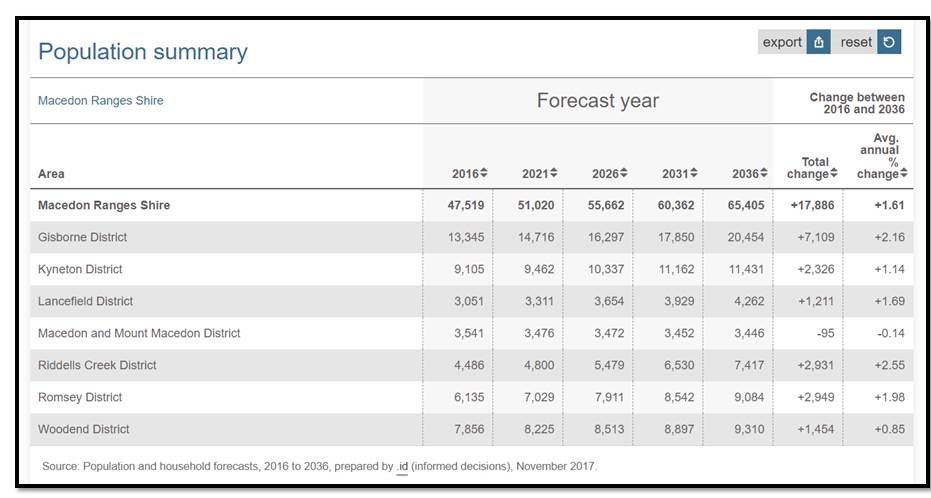
Table 2: All the major towns in Macedon Ranges Shire are forecast to increase in population at least up until 2036 which means more people will be using local minor rural roads for exercise and nature observation in conjunction with vehicles that can currently travel at up to 100km per hour. Source: Macedon Ranges Shire website.
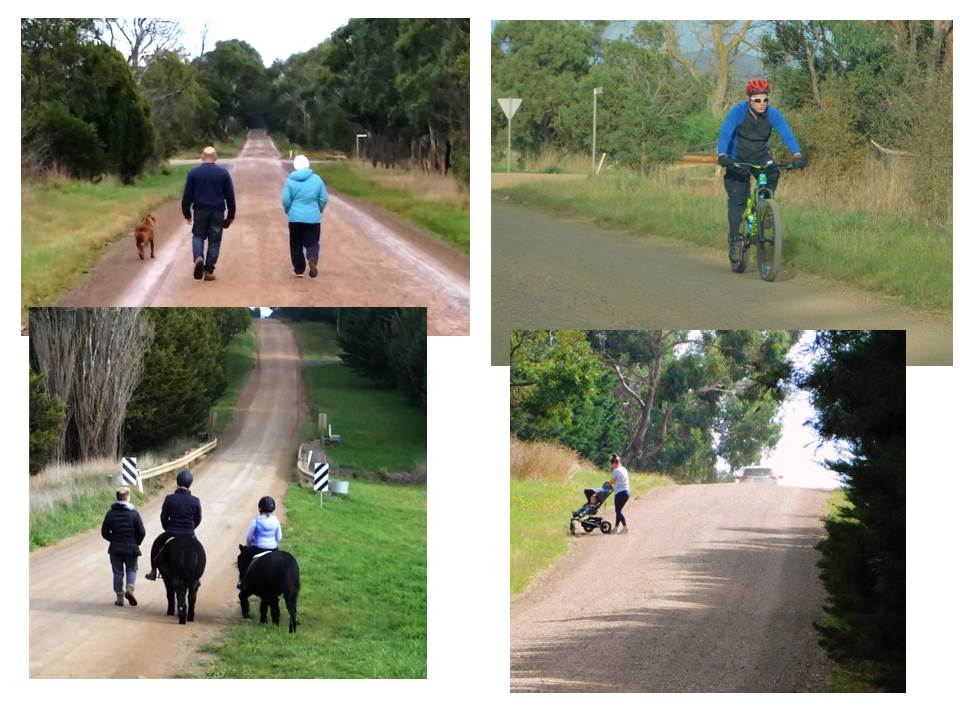
Figure: Non-traditional road users, walkers, bike riders, nature observers and horse riders are increasing in number on some Shire roads close to towns. Their safety is threatened by Department of Transport default 100km per hour speed limit Guidelines which fail to embrace these activities. Photos show locals using minor rural roads in the circuit south west of Romsey managed by the Shire where the default vehicle speed is 100km per hour. Photos: Patrick Francis.
An increasing number of people moving to Shire towns for lifestyle change and being closer to nature use nearby rural roads for exercise for their health and well-being. A typical example is the Moffats lane, Black Range road, Kerrie road, Knox road circuit adjacent to the south west side of Romsey and the new Lomandra estate. These principally category 4 and 5 rural roads are increasingly being used by pedestrians and bike riders. Many walk, jog, exercise dogs and cycle the entire 8km circuit.
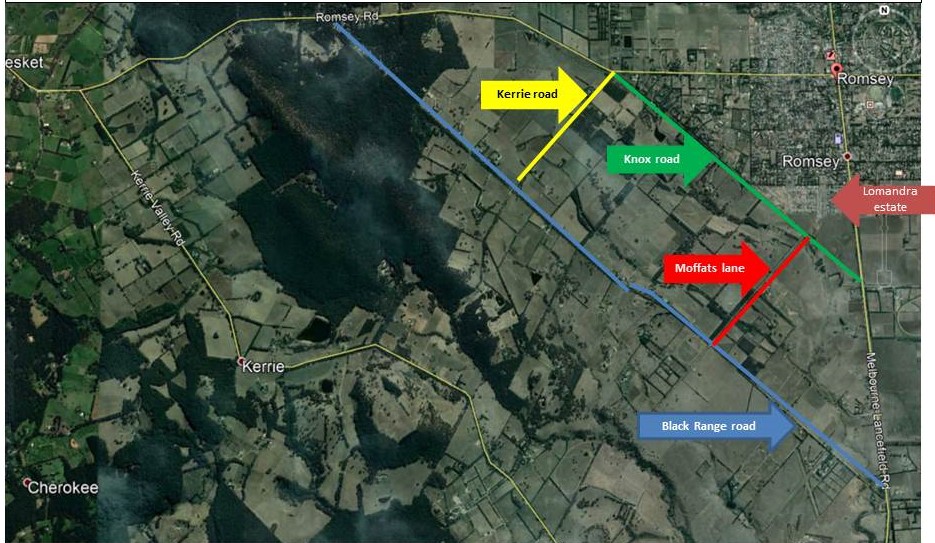
Figure: New housing estates in Macedon Ranges Shire have brought a new demographic of residents keen to use local rural roads outside town boundaries for exercise and nature experiences. This image depicts the Moffats lane, Black Range road, Kerrie, road Knox road circuit through the farming zone south west of Romsey.
Despite this there has been no change to the default 100km per hour speed limit imposed on these road via the VicRoads “Traffic Engineering Manual Volume 3 – Additional Network Standards & Guidelines Speed Zoning Guidelines Edition 1, June 2017”. This means pedestrians, bike riders, and joggers share the road with vehicles, including trucks such as semi-trailers and B-doubles which can legally travel at 100km per hour.
This is an untenable safety issue for these pedestrians/bike riders because these roads are mostly gravel, narrow, have single lane bridges, dips and crests. In many sections the verges are entirely covered with tree and shrub vegetation making escaping the gravel surface to avoid passing/overtaking vehicles difficult. Verges may also be habitat for wildlife such as snakes which in a coincidence of event with a passing vehicle may lead to pedestrian injury.
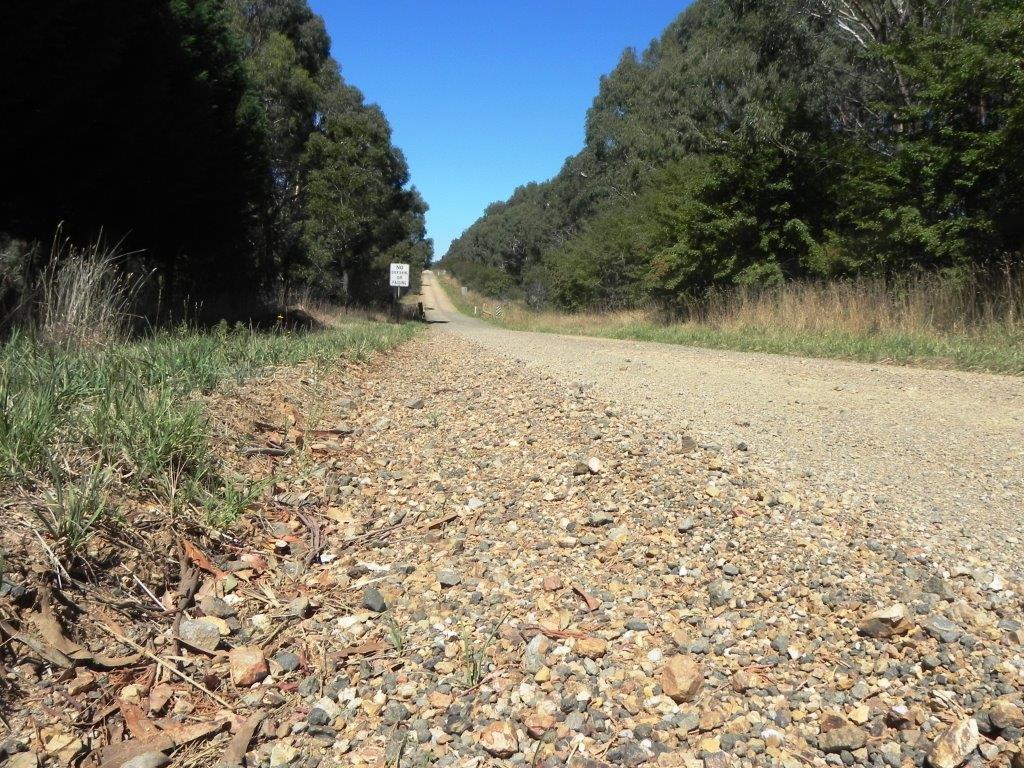
Figure: Many of the category 4, 5 and 6 rural roads adjacent to towns being used by pedestrians have gravel surfaces from which stones can be thrown with serious injury consequences as vehicles overtake or pass at up to 100km per hour. Photo: Moffats lane Romsey, Patrick Francis.
The objectives of this road safety strategy include protecting and enhancing the natural environment. Currently the failure to reduce vehicle speed on these rural roads is causing significant harm to wildlife through increasing road kills. This is being exacerbated around some Shire towns as populations increase and some minor rural roads are being used as high speed short-cuts. Reducing speed on these service roads to around 40 – 50km per hour will reduce road kills and make them less attractive as short-cuts.
The safety threat is not confined to pedestrians/bike riders on some of these roads. Vehicles travelling at speeds in excess of 50km per hour have difficulty avoiding collisions particularly large animals like kangaroos. In this situation drivers are inclined to swerve to avoid collision and run into a tree or drain on the verge. Ability to retain control of a vehicle is reduced by the loose stone gravel on these roads. Insurance company statistics highlight the increasing number of claims associated with wildlife collisions especially in the peri-urban regions around Melbourne, table 3.
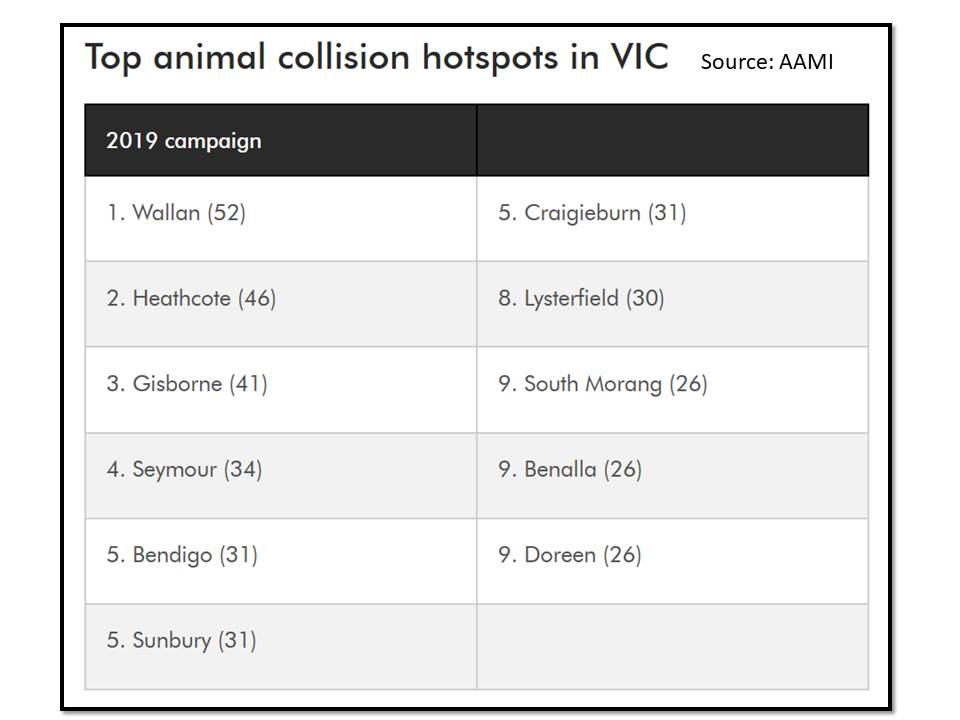
Table 3: AAMI’s 2019 insurance claims for vehicle collisions with wildlife. Most of the incidents are occurring on roads in the peri-urban region including Macedon Ranges Shire. There are no records kept for collisions with wildlife that cause injuries to vehicle occupants.
The 100km per hour speed limit also has safety concerns for local residents who live and farm along the category 3, 4, 5 and 6 rural roads. The objective to “access locations in a safe and timely manner” is currently compromised because the maximum speed threatens accidents when turning into or leaving properties. Given many landowners and particularly those involved in wildlife conservation programs travel at 40 – 50km per hour along these rural roads to ensure the safety of wildlife and pedestrians, the potential for harassment and anti-social behaviour from drivers travelling at 100km per hour is ever-present.
This difference in attitude to speed on the minor rural roads is a significant safety threat to all vehicle drivers and is likely to lead to more collisions.
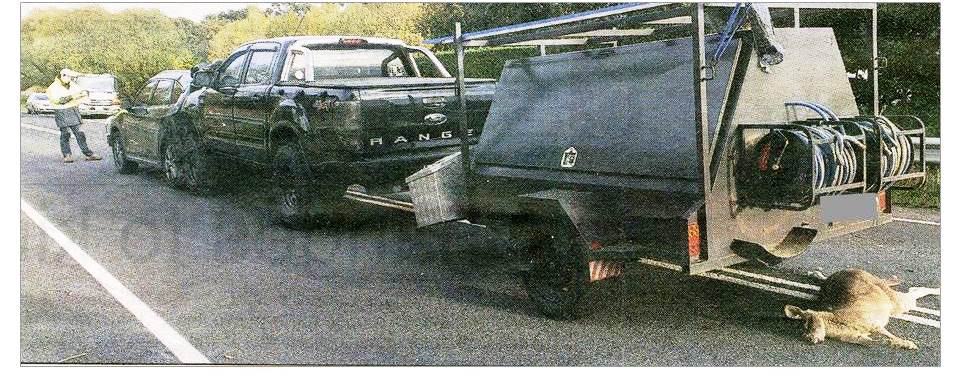
Figure: When vehicle drivers have widely different attitudes to what speed is safe to travel at to protect themselves and wildlife on rural roads where the maximum default speed is 100km per hour, conditions are set for up for more collisions between vehicles and unsociable driver behaviour. Photo: Midland Express.
It’s a similar safety situation associated with slow farm vehicles such as tractors towing implements using these roads to access nearby properties. Aggressive behaviour such as tail gating and dangerous overtaking is increasingly common.
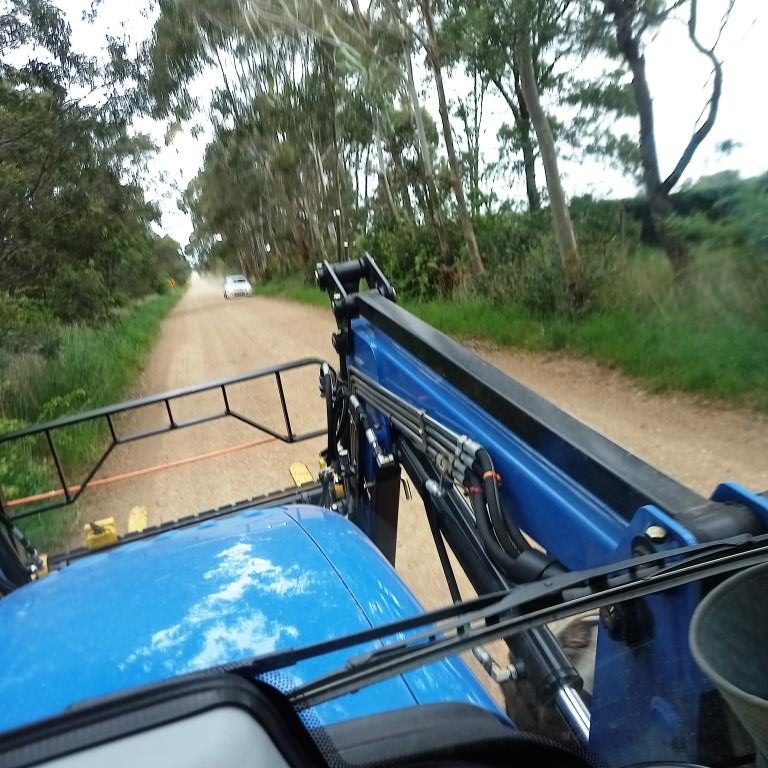
Figure: On narrow gravel roads with trees on the verge, the 100km per hour default maximum speed limit creates a safety threat for occupants in farm vehicles travelling at around 20km per hour and those in vehicles travelling at up to 100km per hour. Photo: Patrick Francis.
A solution for improved safety is available
Council has a duty of care for the well-being of all its residents as well as for wildlife under its Biodiversity Policy. The new demographics of Shire towns and the lack of appreciation of many new drivers towards safety on category 3, 4, 5 and 6 roads means the Mobility and Road Safety Strategy needs to ensure that Council in conjunction with the Department of Transport, amend the default maximum speed limits. This is urgently needed for the rural roads within a 5km radius of all major town boundaries where the roads are being used for exercise and nature observation.
The mechanism to change the default speed limit is available through VicRoads “Traffic Engineering Manual Volume 3 – Additional Network Standards & Guidelines Speed Zoning Guidelines Edition 1, June 2017”. It states: “The speed zoning principles, …are categorised under the following key themes for the setting of speed limits:
• Road Safety
• Transport Network Efficiency
• Road User Expectation
• Community Engagement
• Community Wellbeing”
When any of these five themes are failing to ensure road users safety then the default 100km per hour speed limit can be adjusted down.
Road Safety
This theme states: “Where vehicle speeds would result in impact forces exceeding human tolerances to vehicle occupants and/or vulnerable road users, then speeds should be managed to minimise the risk of fatal and serious injury.” Pedestrians are vulnerable road users.
Transport Network Efficiency
This theme states: “When determining a speed limit for a road, it should generally be set in accordance with road function and standard of infrastructure. ….When determining speed limits, the objective is to achieve operating speeds that support an efficient network wide outcome. It is essential that decisions do not just focus on isolated sections of road but are made in the context of the overall route and the adjoining road network. Speed limits should be set to support efficient travel on roads that have a primary movement function and discourage inappropriate use of roads and streets that have a primary access or place function.”
The last sentence is telling in the context of the use of Black Range road and Moffats lane as short cuts by an increasing number of drivers to access the new housing estate in Romsey or alternatively to avoid Romsey township altogether to access the Woodend road. These roads have a primary access function for local farmers and land owners, they are not highways with primary movement function. The road rage and threatening driver behaviour is a consequence of not having a speed restriction compatible with an access function.
Road user expectation principles
This reads: “When determining a speed limit, it should be set so that it is consistent with speed limits on roads in a similar environment with similar characteristics and function. Speed limits should be set in a consistent manner…. minimising the number of speed limit changes is a key objective.”
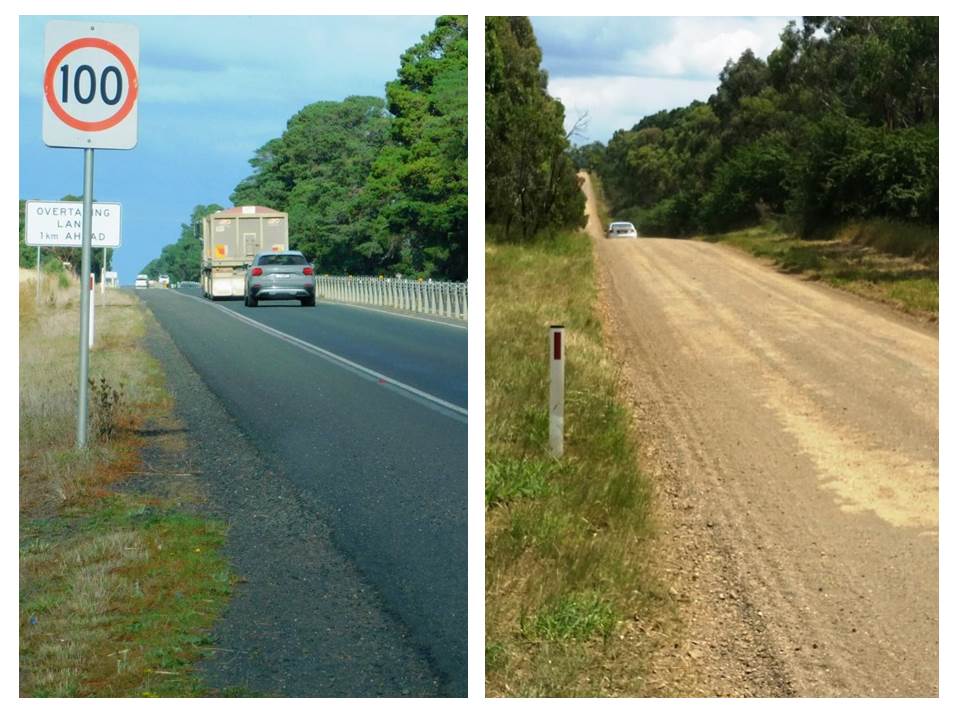
Figure: The ‘road user expectation’ principle is being ignored when the maximum speed limit on major bitumen highways with their accompanying safety hardware is the same as minor rural roads with few if any safety hardware. Photos show Melbourne Romsey road left and Moffats lane right, both have the maximum speed limit set at 100km per hour. Photos: Patrick Francis.
The existing default 100km per hour speed limit denies drivers any speed guidance to avoid the possible dangers associated with collisions with pedestrians, bike riders and wildlife on category 3, 4, 5 and 6 local roads. The default speed limit also fails to alert drivers to increased dangers associated with driving on gravel surfaces compared to the surface stability provided by bitumen in conjunction with its associated safety hardware.
Community engagement principle
This reads: “When determining or changing a speed limit, engagement with affected communities and road users shall be undertaken so that expectations and impacts are understood and considered. Engagement is important to be able to gauge the level of support that the community and road users have for speed limit changes. A high level of support and awareness will result in better outcomes for the community through better acceptance of, and compliance with, speed limits.”
MRSC has been given petitions by residents about pedestrian and wildlife safety being threatened by the 100km per hour speed limit on category 3,4,5 and 6 rural roads adjacent to towns. Advice from the Department of Transport is that the Shire must initiate any request to reduce the default maximum speed limit on any of the rural roads under its jurisdiction. The Department of Transport makes the decision about speed limits.
Community wellbeing principle
This reads: “Speed limits should be set at a level that supports active transport modes and minimises impacts on amenity.Local residential roads that do not provide a through traffic function generally have low volumes of traffic. In these instances speed limits should be set at a level to enhance amenity and encourage an increased use of active transport modes.”
Department of Transport and MRSC are yet to address this wellbeing principle despite requests for change to the default 100km per hour speed limit on some category 3, 4, 5 and 6 rural roads within 5km radius of towns.
The way ahead for road safety
The five principles on which the default speed limit on rural roads is based are not being adhered to in regard to public safety and should form the basis for MRSC negotiating change with the Department of Transport for minor rural roads frequented by pedestrians, bike riders and wildlife.
Ironically the Department of Transport (VicRoads) Guidelines already provide an opportunity for Council to make the case for lower speed limits on rural roads. They state: “In areas where there are high levels of pedestrian activity or the risk to pedestrians is high, the speed limit …. should be reviewed and a lower speed limit adopted where appropriate…. .” The instigator for change must be the Shire council. This rural road safety strategy provides the Council with the avenue for negotiating change to the default speed limit on sections of minor rural roads.
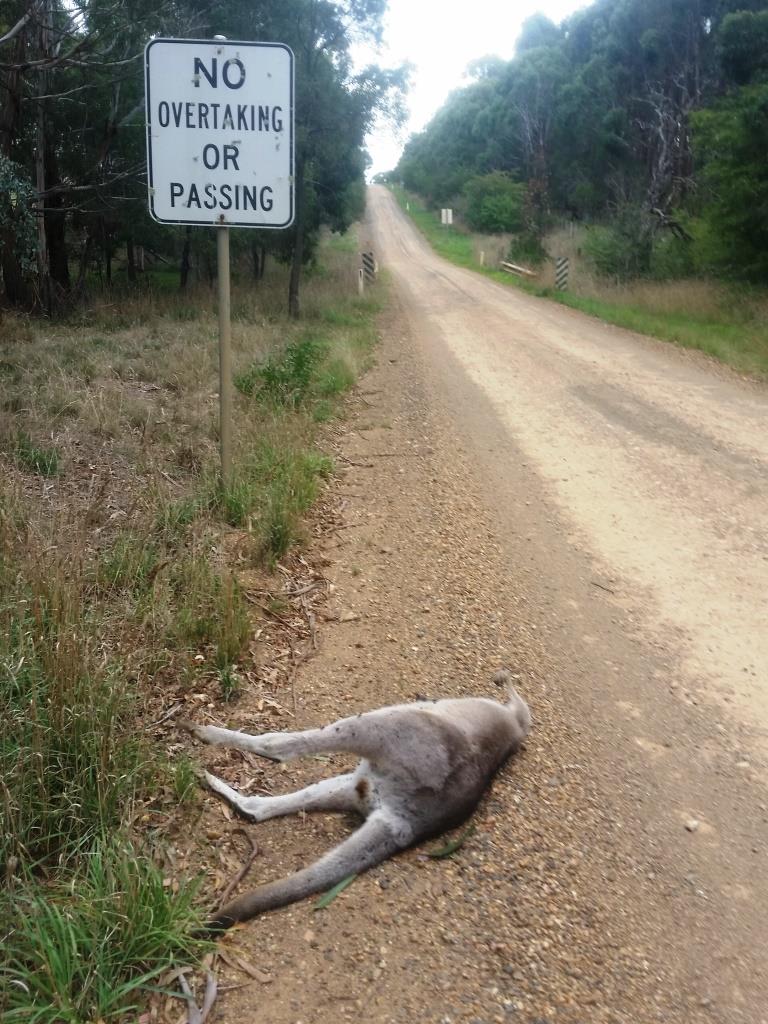
Figure: Minor rural roads adjacent to towns in the shire which are being used by an increasing number of residents for exercise and nature viewing have significant danger hot spots, such as wildlife crossing, narrow single lane bridges, crests, dips, trees on the verges, loose stone edges and dust. An increasing number of wildlife crossing these roads are being killed and injured as drivers travelling above 50km per hour cannot stop in time to prevent a collision or run over. Photo: Wildlife road kill, Moffats lane Romsey, Patrick Francis.

